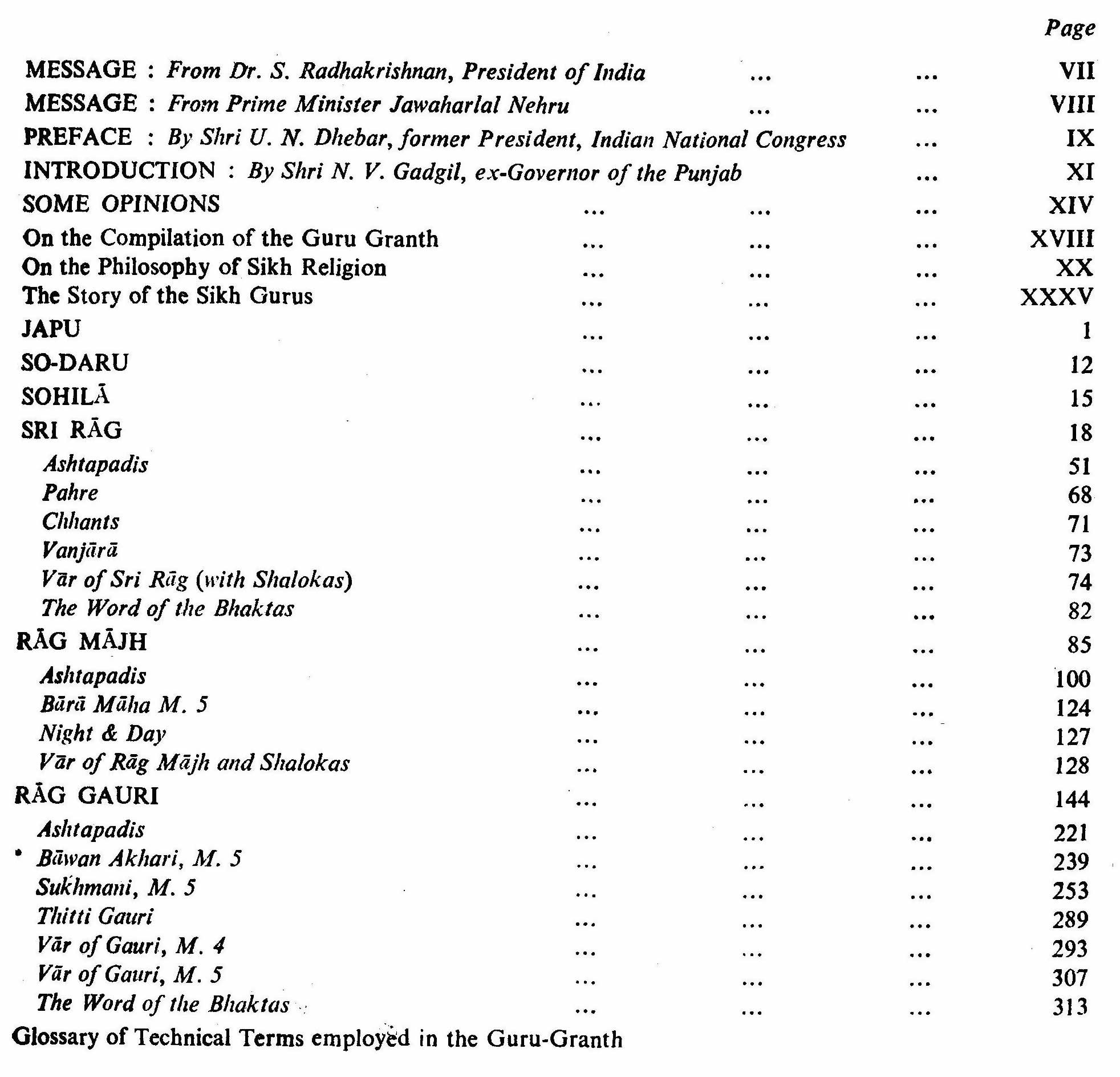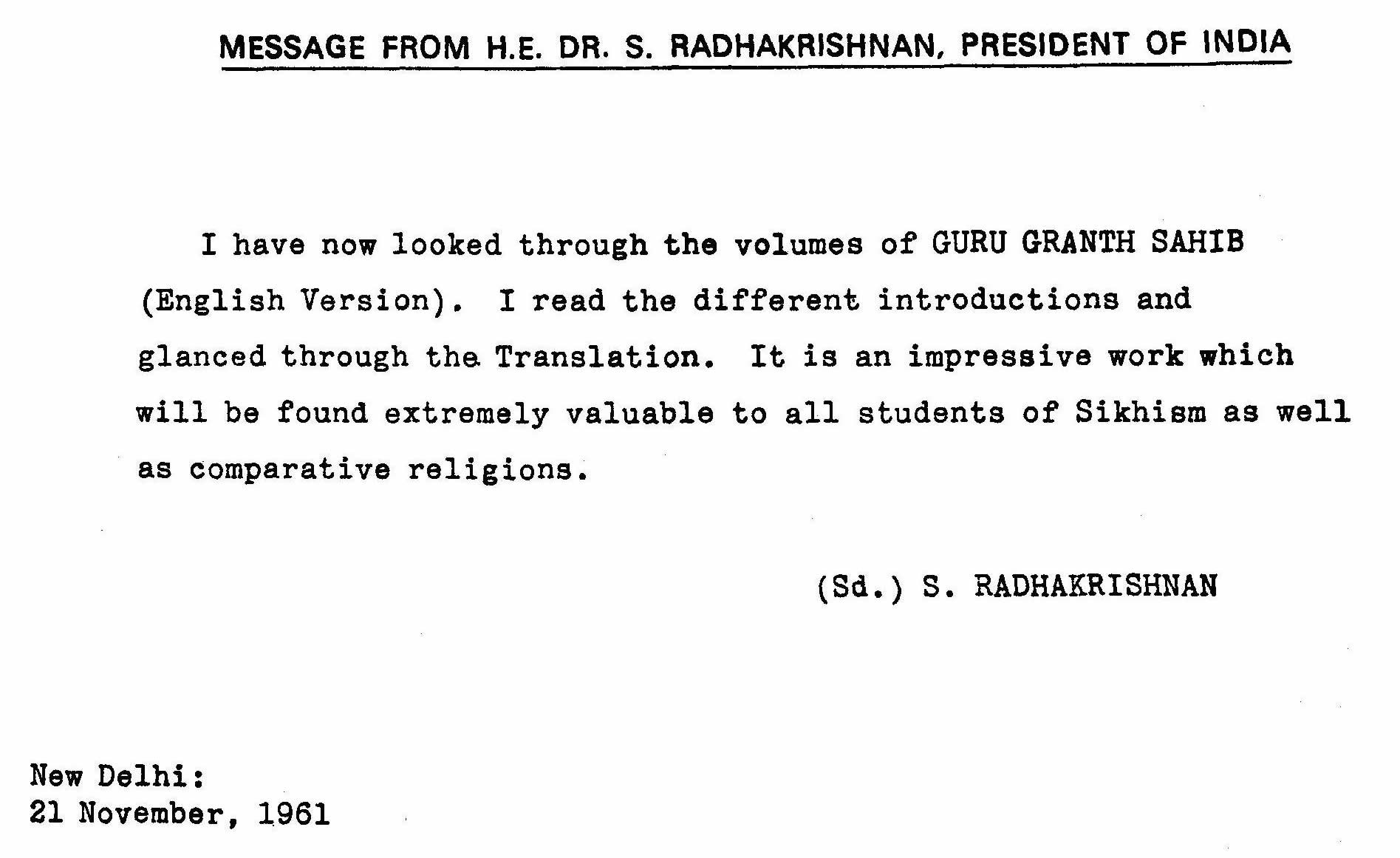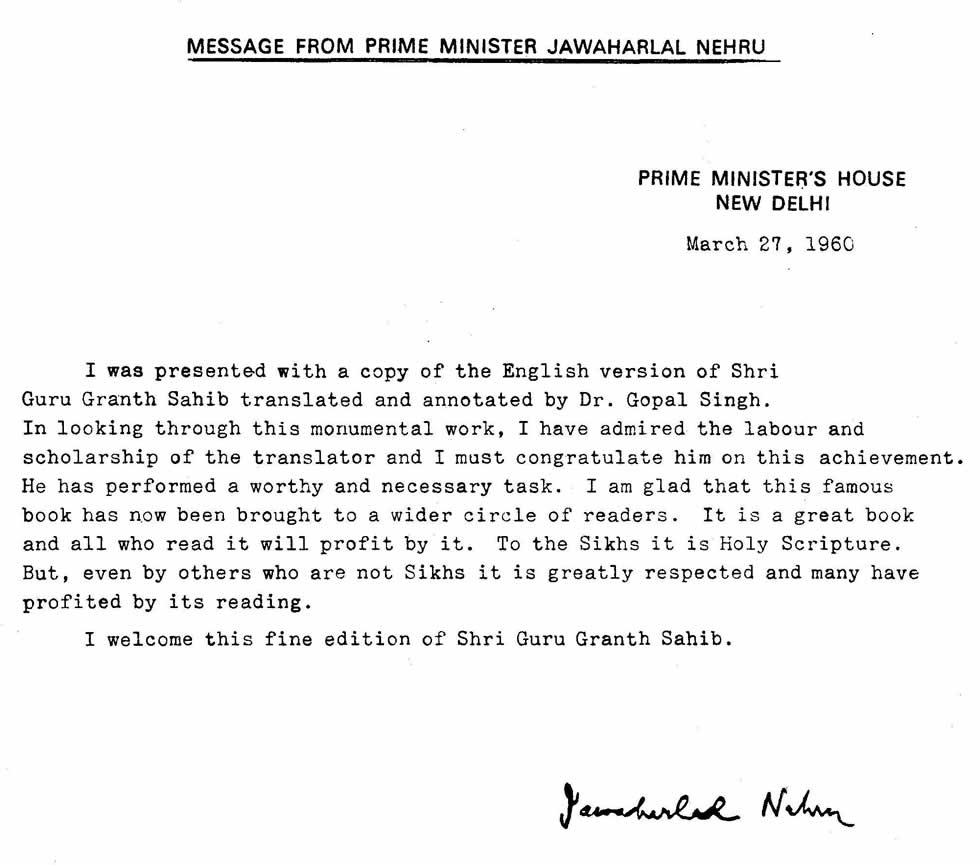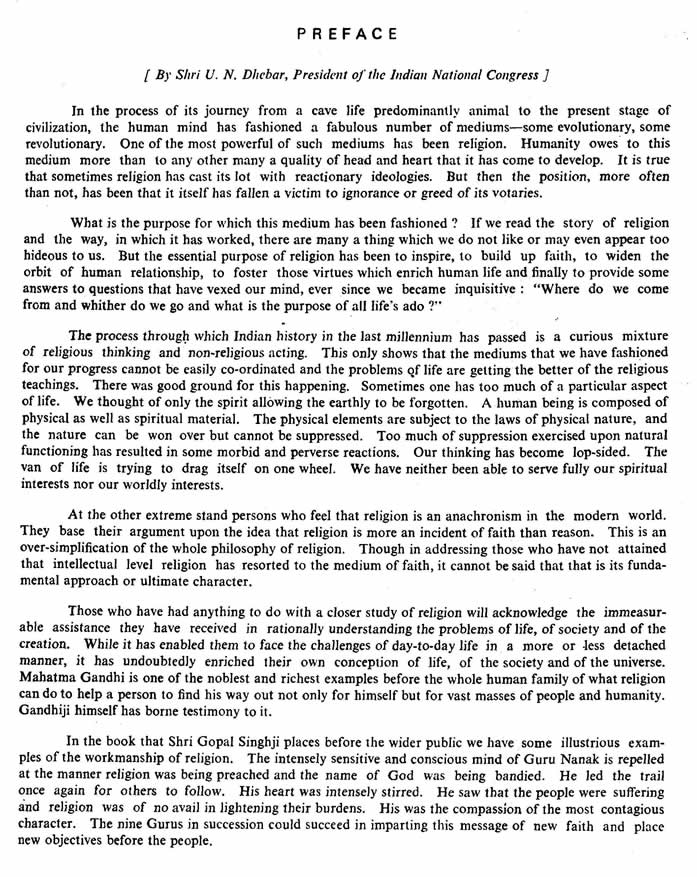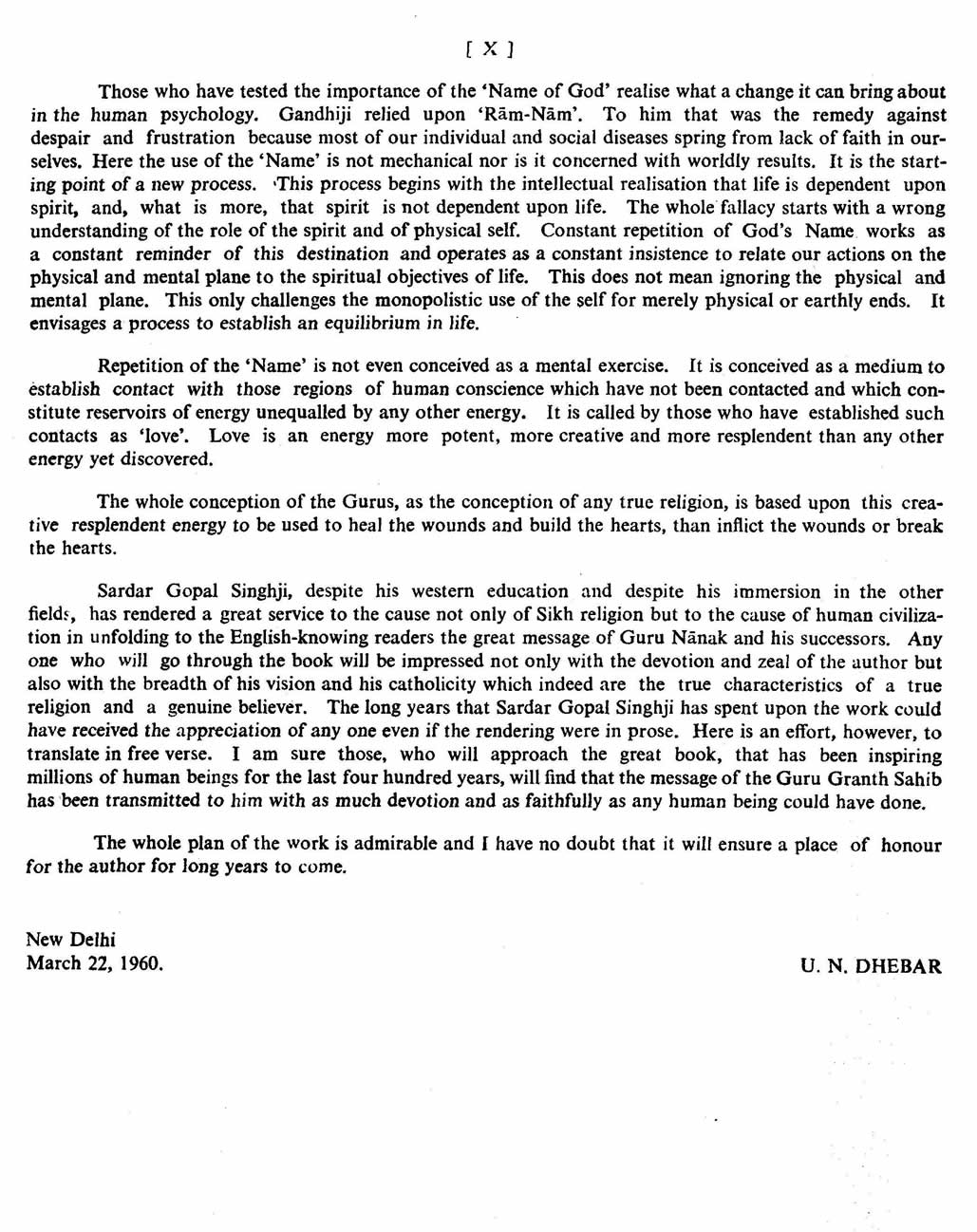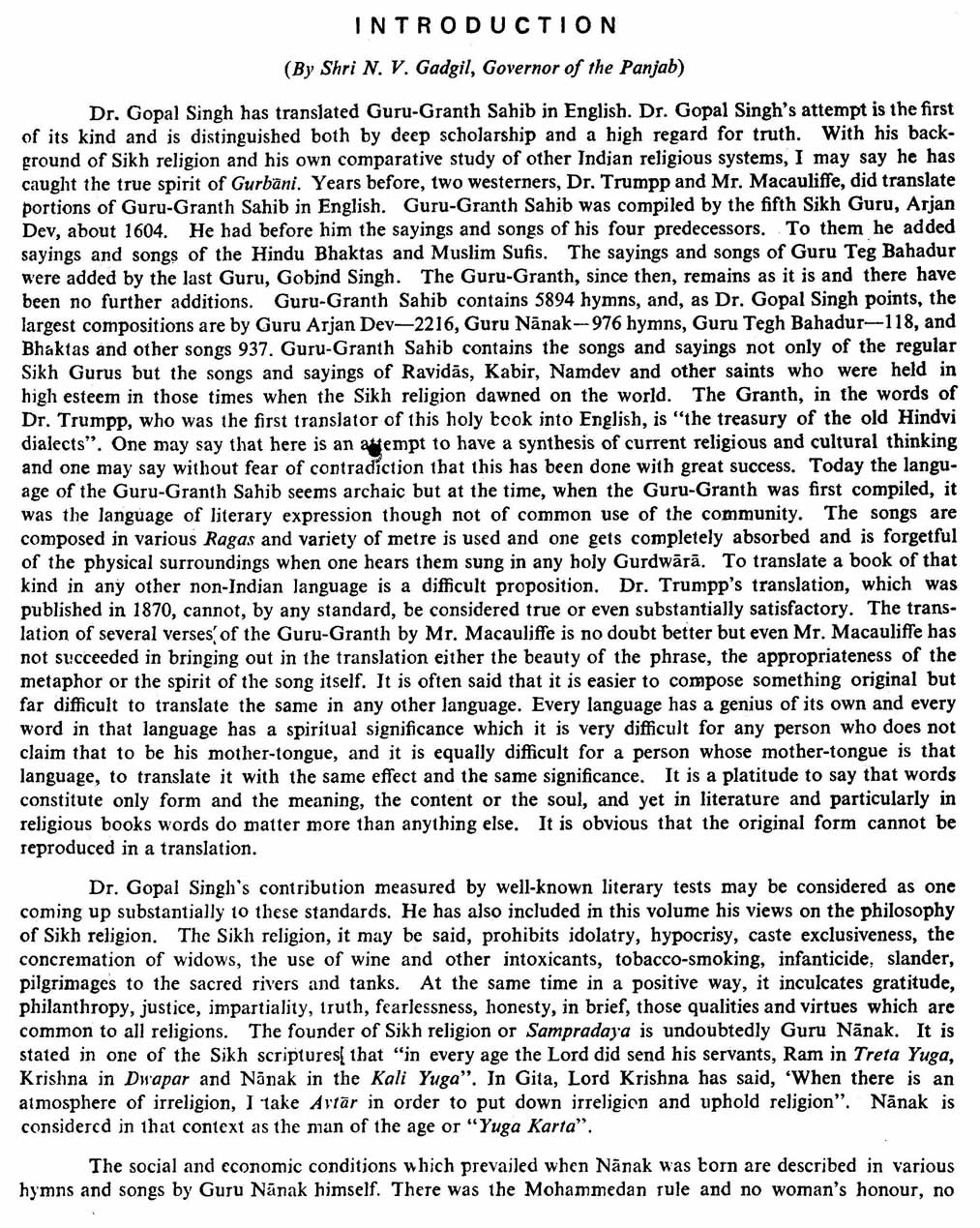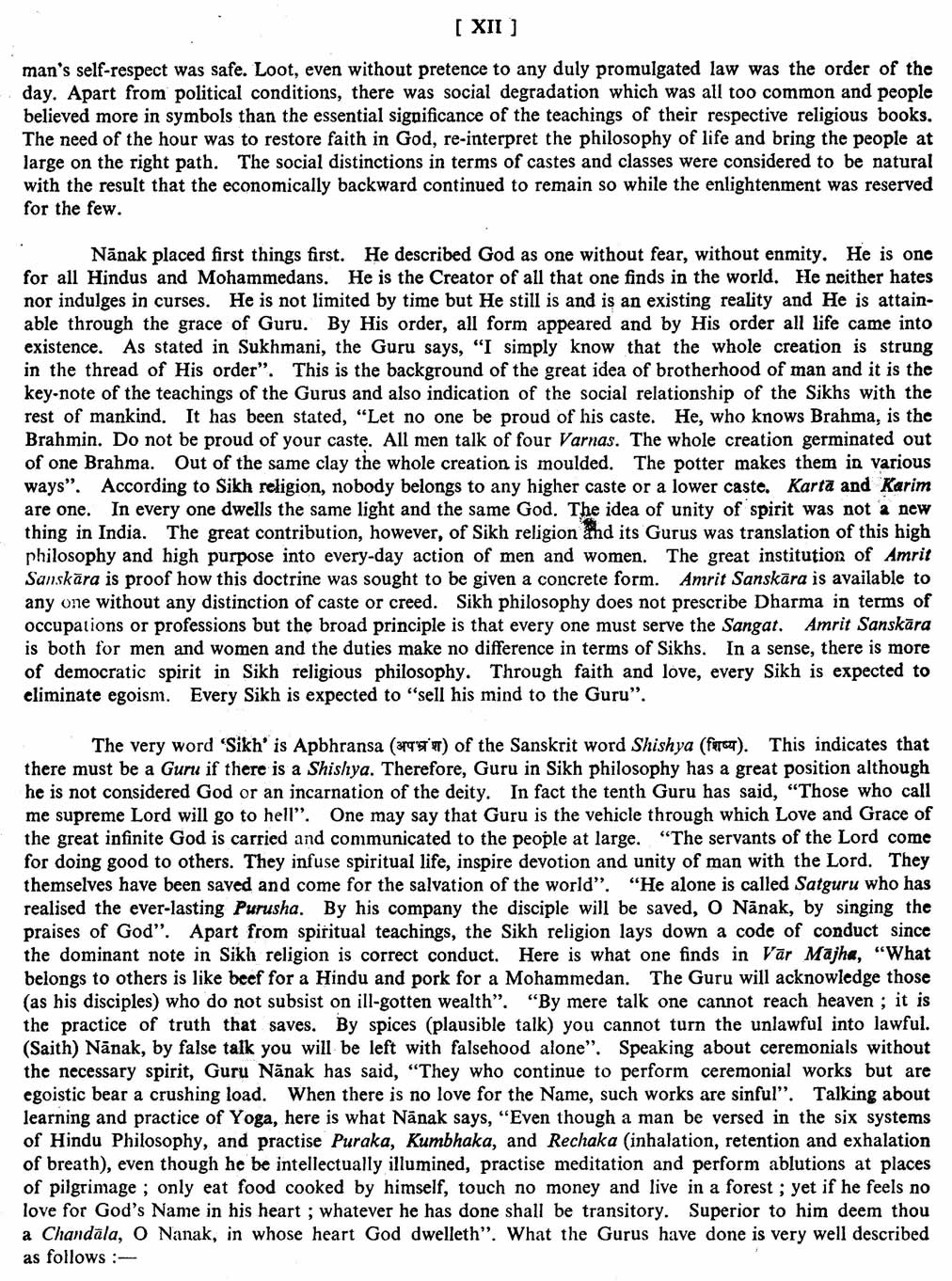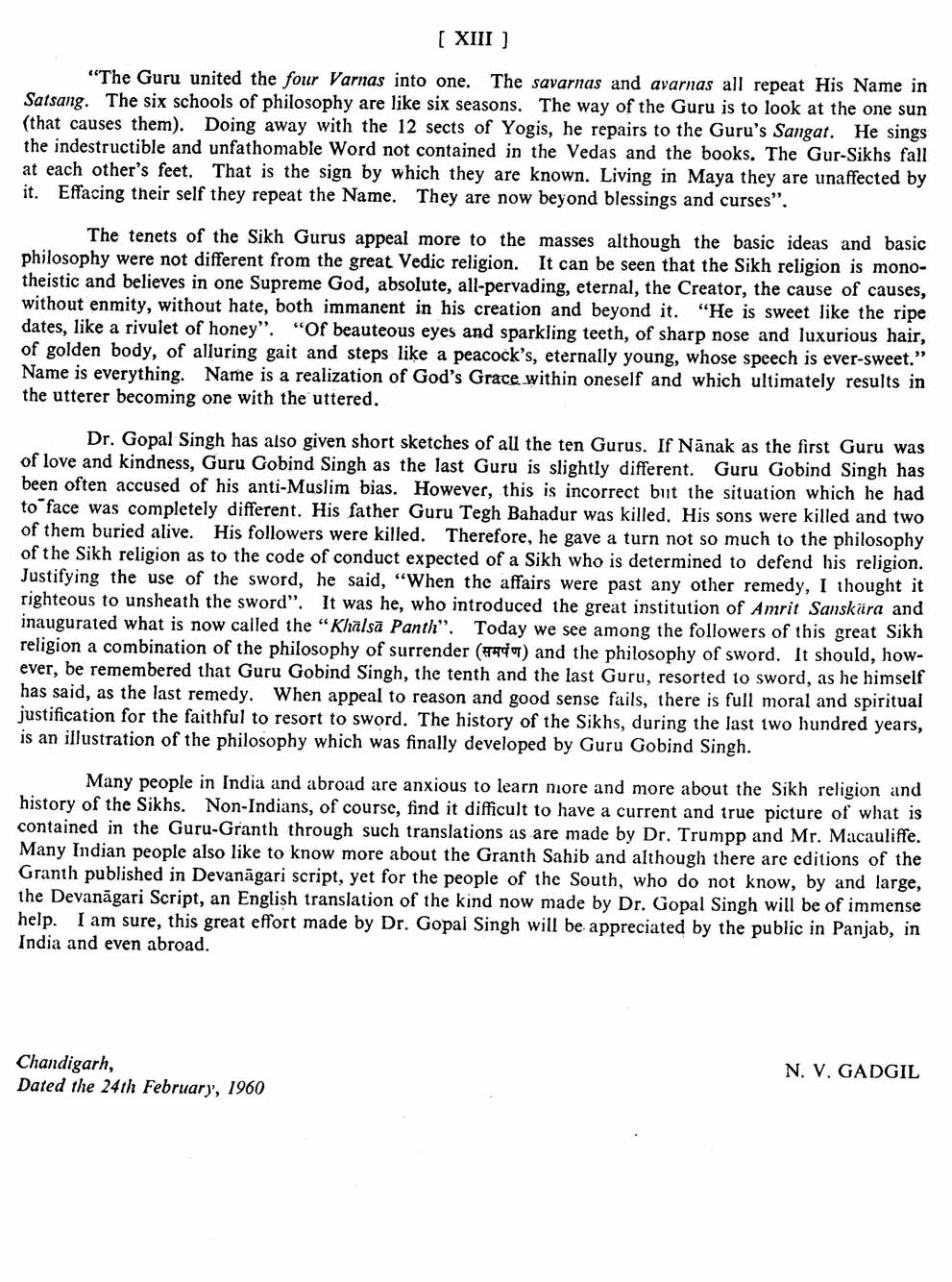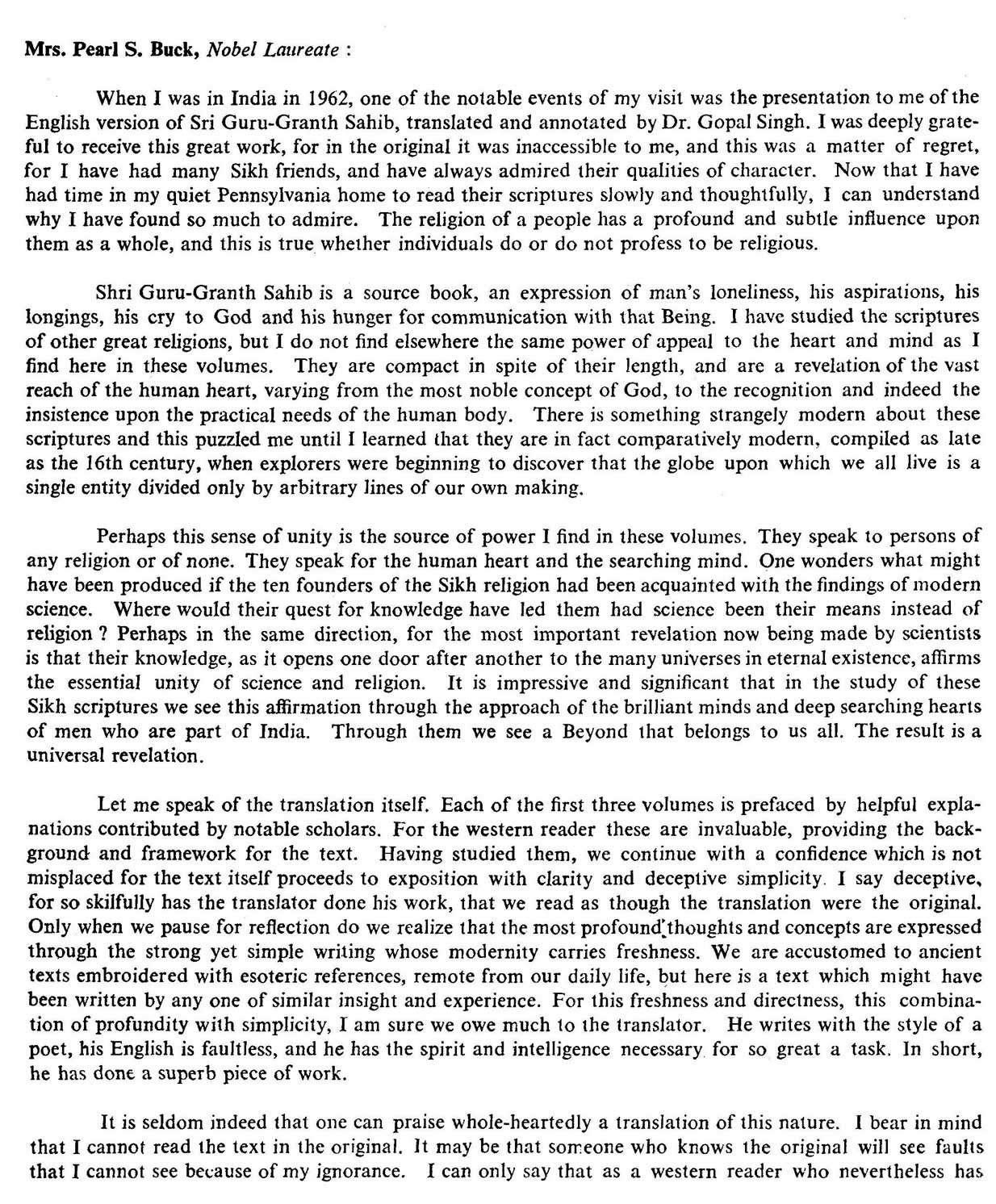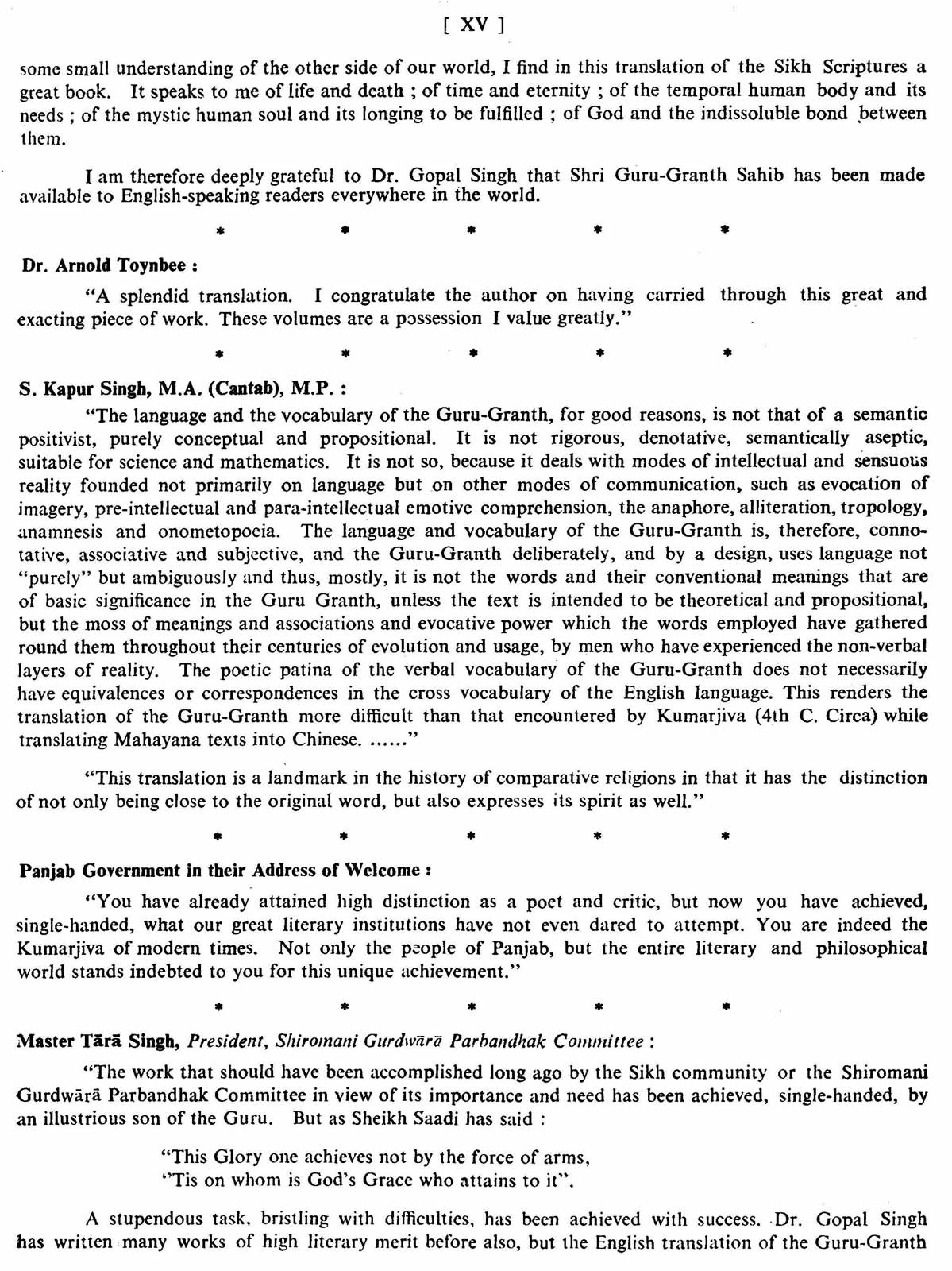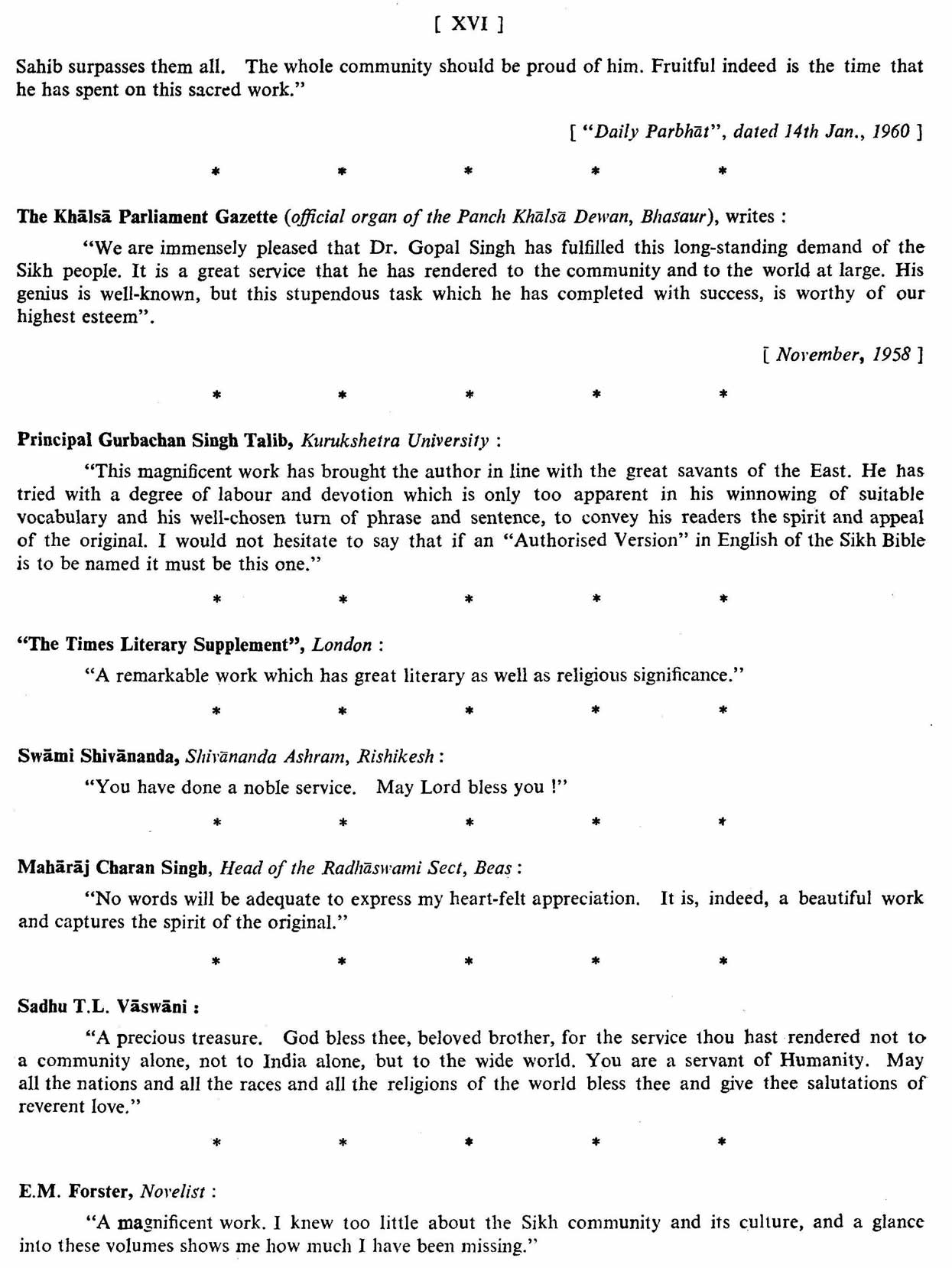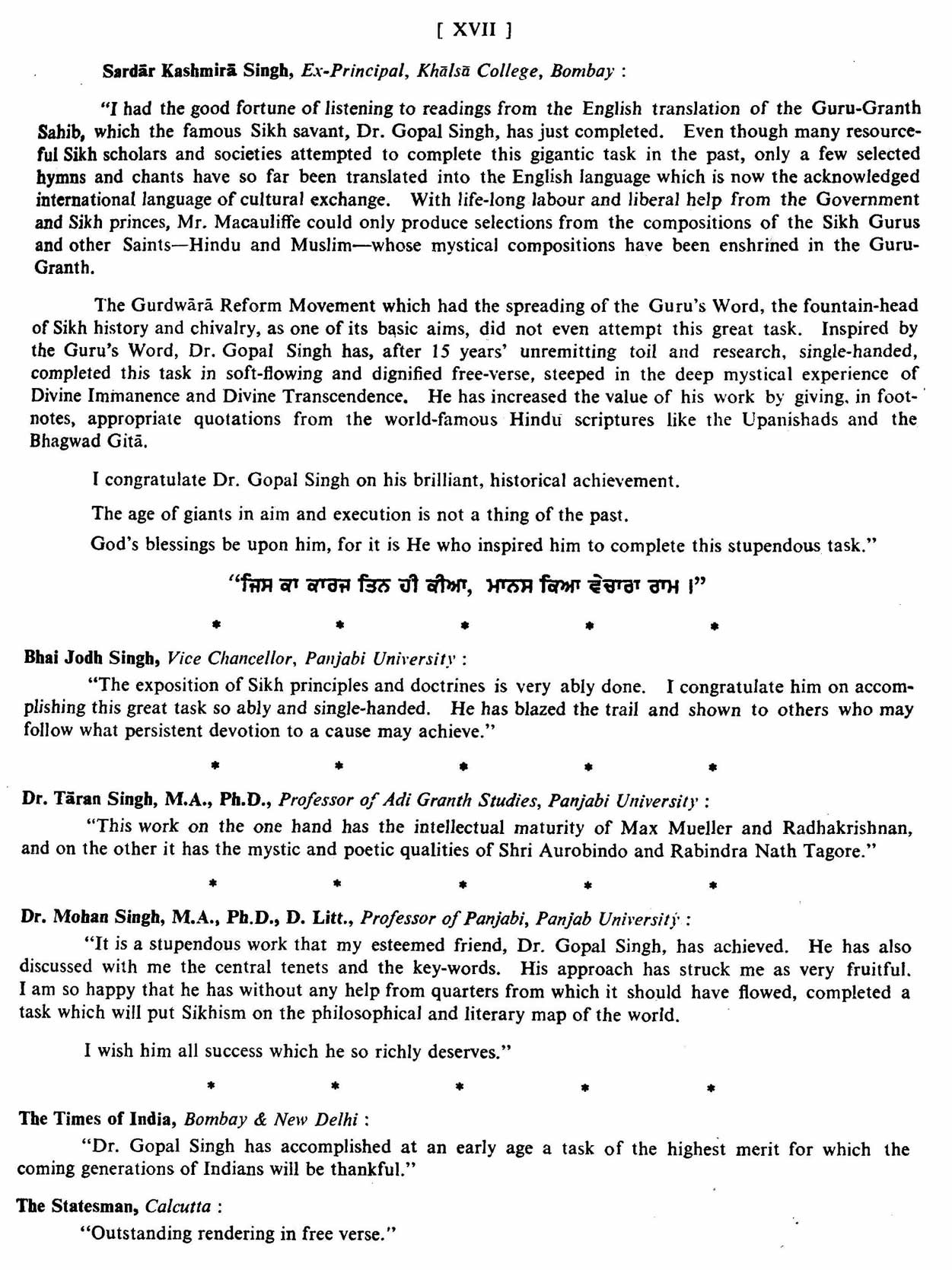Sri Guru Granth Sahib by Dr Gopal Singh
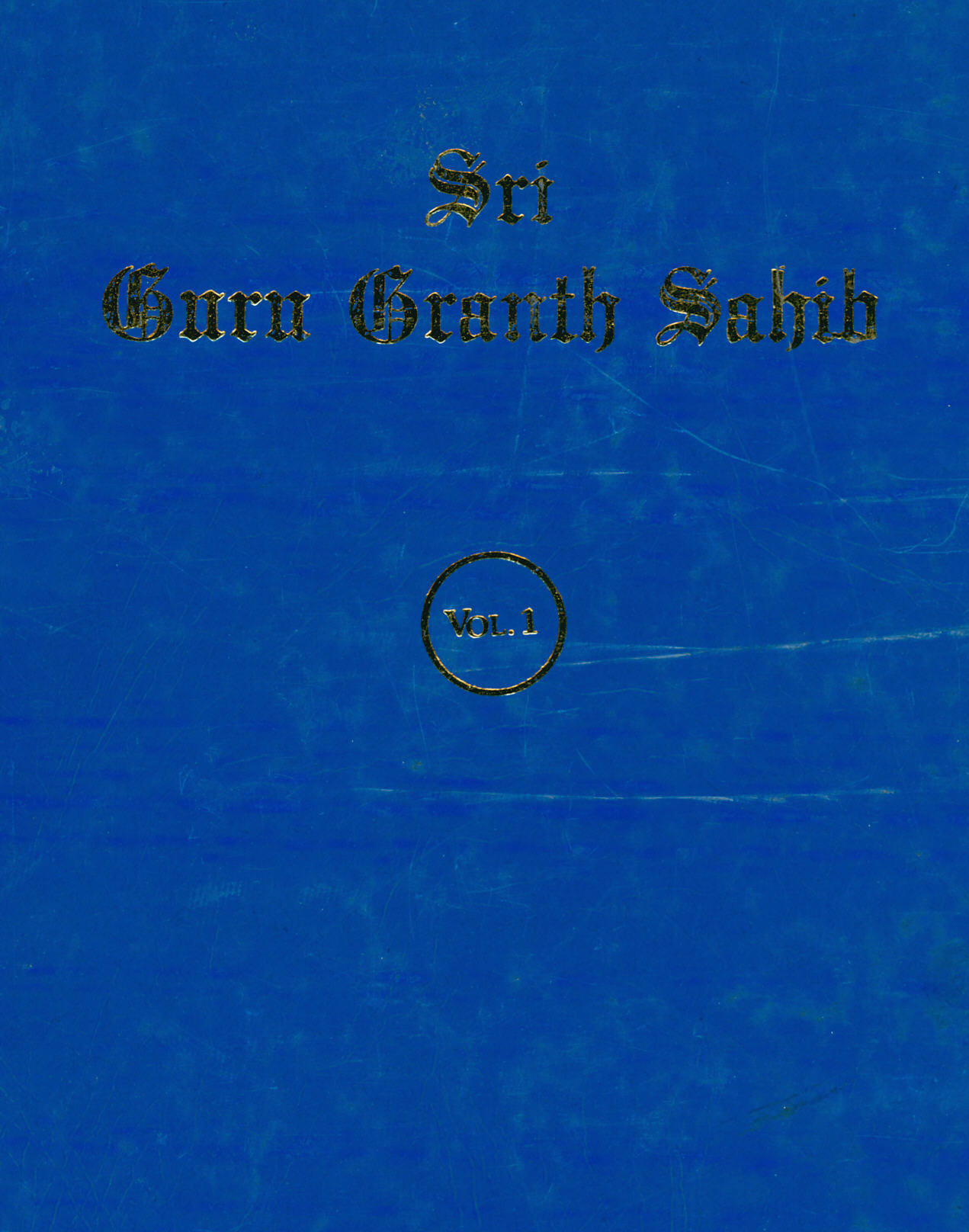
Dr Gopal Singh was responsible for completing the first complete translation of the Sri Guru Granth Sahib into English in 1960. It believed that initially it was published in 2 volumes although the present publications are published in a four volume set. As the first English translation, it was very welcomed by non-Punjabi readers and received a wide distribution. The 'International Edition' published by the World Sikh University Press in 1978, has a light blue cover.
Dr. Gopal Singh's stellar reputation for scholarly work in service of the Dharma is well deserved. In fact, the introduction to the work, in the first of the four volumes, is a remarkable work in and of itself. Especially readable and worthwhile is Section II: On the Philosophy of Sikh Religion. In this treatise on comparative religion, he traces the common threads of religious thought throughout the ages, giving one a deeper appreciation of Sikh Dharma. His brief explanation of the Kundalini and Yogic traditions is well-done.
Volume 1
Table of contents
| MESSAGE : From Dr. S. Radhakrishnan, President of India | VII |
| MESSAGE : From Prime Minister Jawaharlal Nehru | VIII |
| PREFACE By Sun U. N. Dhebar, former President, Indian National Congress | IX |
| INTRODUCTION : By Shri N. V. Gadgil, ex-Governor of the Punjab | XI |
| SOME OPINIONS | XIV |
| On the Compilation of the Guru Granth | XVIII |
| On the Philosophy of Sikh Religion | XX |
| The Story of the Sikh Gurus | XXXV |
| JAPU | 1 |
| SO-DARU | 12 |
| SOHILA | 15 |
| SRI RAG | 18 |
| Ashtapadis | 51 |
| Pahre | 68 |
| Chhants | 71 |
| Vanjärã | 73 |
| Var of Sri Rag (with Shalokas) | 74 |
| The Word of the Bhaktas | 82 |
| RAG MAJH | 85 |
| Ashtapadis | 100 |
| Bärä Maha M. 5 | 124 |
| Night & Day | 127 |
| Var of Rag Majh and Shalokas | 128 |
| RAG GAURI | 144 |
| Ashtapadis | 221 |
| Bãwan Akhari, M. 5 | 239 |
| Sukhmani, M. 5 | 253 |
| Thitti Gauri | 289 |
| Var of Gauri, M. 4 | 293 |
| Var of Gauri, M. 5 | 307 |
| The Word of the Bhaktas | 313 |
Glossary of Technical Terms employed in the Guru-Granth
- —The pages of the original text are given in black type in the margin. Words with a spiritual
significance begin with capital letters throughout the translated version
- —The pages of the original text are given in black type in the margin. Words with a spiritual
Message from President of India
| MESSAGE FROM H.E. DR. S. RADHAKRISHNAN, PRESIDENT OF INDIA |
|---|
| I have now looked through the volumes of GURU GRANTH SAHIB (English Version). I read the different introductions and glanced through tha Translation. It is an impressive work which will be found extremely valuable to all students of Sikhism as well as comparative religions. |
| (Sd.) S. RADHAKRISHNAN |
| New Delhi: 21 November, 1961 |
Message from Prime Minister
| MESSAGE FROM PRIME MINISTER JAWAHARLAL NEHRU |
|---|
| PRIME MINISTER’S HOUSE NEW DELHI March 27, 1960 |
| I was presented with a copy of the English version of Shri Guru Granth Sahib translated and annotated by Dr. Gopal Singh. In looking through this monumental work, I have admired the labour and scholarship of the translator and I must congratulate him on this achievement. He has performed a worthy and necessary task. I am glad that this famous book has now been brought to a wider circle of readers. It is a great book and all who read it will profit by it. To the Sikhs it is Holy Scripture. But, even by others who are not Sikhs it is greatly respected and many have profited by its reading. I welcome this fine edition of Shri Guru Granth Sahib. |
Preface
[By Shri U. N. Dhebar, President of the Indian National Congress]
In the process of its journey from a cave life predominantly animal to the present stage of civilization, the human mind has fashioned a fabulous number of mediums—some evolutionary, some revolutionary. One of the most powerful of such mediums has been religion. Humanity owes to this medium more than to any other many a quality of head and heart that it has come to develop. It is true that sometimes religion has cast its lot with reactionary ideologies. But then the position, more often than not, has been that it itself has fallen a victim to ignorance or greed of its votaries.
What is the purpose for which this medium has been fashioned ? If we read the story of religion and the way, in which it has worked, there are many a thing which we do not like or may even appear too hideous to us. But the essential purpose of religion has been to inspire, to build up faith, to widen the orbit of human relationship, to foster those virtues which enrich human life and finally to provide some answers to questions that have vexed our mind, ever since we became inquisitive : “Where do we come from and whither do we go and what is the purpose of all life’s ado?”
The process through which Indian history in the last millennium has passed is a curious mixture of religious thinking and non-religious acting. This only shows that the mediums that we have fashioned for our progress cannot be easily co-ordinated and the problems o~f life are getting the better of the religious teachings. There was good ground for this happening. Sometimes one has too much of a particular aspect of life. We thought of only the spirit allowing the earthly to be forgotten. A human being is composed of physical as well as spiritual material. The physical elements are subject to the laws of physical nature, and the nature can be won over but cannot be suppressed. Too much of suppression exercised upon natural functioning has resulted in some morbid and perverse reactions. Our thinking has become lop-sided. The van of life is trying to drag itself on one wheel. We have neither been able to serve fully our spiritual interests nor our worldly interests.
At the other extreme stand persons who feel that religion is an anachronism in the modern world. They base their argument upon the idea that religion is more an incident of faith than reason. This is an over-simplification of the whole philosophy of religion. Though in addressing those who have not attained that intellectual level religion has resorted to the medium of faith, it cannot be said that that is its funda¬mental approach or ultimate character.
Those who have had anything to do with a closer study of religion will acknowledge the immeasur¬able assistance they have received in rationally understanding the problems of life, of society and of the creation. While it has enabled them to face the challenges of day-to-day life in a more or .less detached manner, it has undoubtedly enriched their own conception of life, of the society and of the universe. Mahatma Gandhi is one of the noblest and richest examples before the whole human family of what religion can do to help a person to find his way out not only for himself but for vast masses of people and humanity. Gandhiji himself has borne testimony to it.
In the book that Shri Gopal Singhji places before the wider public we have some illustrious exam¬ples of the workmanship of religion. The intensely sensitive and conscious mind of Guru Nanak is repelled at the manner religion was being preached and the name of God was being bandied. He led the trail once again for others to follow. His heart was intensely stirred. He saw that the people were suffering and religion was of no avail in lightening their burdens. His was the compassion of the most contagious character. The nine Gurus in succession could succeed in imparting this message of new faith and place new objectives before the people.
Those who have tested the importance of the ‘Name of God’ realise what a change it can bring about in the human psychology. GandhUi relied upon ‘Rãm-Nam’. To him that was the remedy against despair and frustration because most of our individual and social diseases spring from lack of faith in our¬selves. Here the use of the ‘Name’ is not mechanical nor is it concerned with worldly results. It is the start¬ing point of a new process. ~This process begins with the intellectual realisation that life is dependent upon spirit, and, what is more, that spirit is not dependent upon life. The whole fallacy starts with a wrong understanding of the role of the spirit and of physical self. Constant repetition of God’s Name works as a constant reminder of this destination and operates as a constant insistence to relate our actions on the physical and mental plane to the spiritual objectives of life. This does not mean ignoring the physical and mental plane. This only challenges the monopolistic use of the self for merely physical or earthly ends. It envisages a process to establish an equilibrium in life.
Repetition of the ‘Name’ is not even conceived as a mental exercise. It is conceived as a medium to establish contact with those regions of human conscience which have not been contacted and which con¬stitute reservoirs of energy unequalled by any other energy. It is called by those who have established such contacts as ‘love’. Love is an energy more potent, more creative and more resplendent than any other energy yet discovered.
The whole conception of the Gurus, as the conception of any true religion, is based upon this crea¬tive resplendent energy to be used to heal the wounds and build the hearts, than inflict the wounds or break the hearts.
Sardar Gopal Singhji, despite his western education and despite his immersion in the other fieId~, has rendered a great service to the cause not only of Sikh religion but to the cause of human civiliza¬tion in unfolding to the English-knowing readers the great message of Guru Nanak and his successors. Any one who will go through the book will be impressed not only with the devotion and zeal of the author but also with the breadth of his vision and his catholicity which indeed are the true characteristics of a true religion and a genuine believer. The long years that Sardar Gopal Singhji has spent upon the work could have received the appreciation of any one even if the rendering were in prose. Here is an effort, however, to translate in free verse. I am sure those, who will approach the great book, that has been inspiring millions of human beings for the last four hundred years, will find that the message of the Guru Granth Sahib has been transmitted to him with as much devotion and as faithfully as any human being could have done.
The whole plan of the work is admirable and I have no doubt that it will ensure a place of honour for the author for long years to come.
Introduction
(By Shri N. V. Gadgil, Governor of the Panjab)
Dr. Gopal Singh has translated Guru-Granth Sahib in English. Dr. Gopal Singh’s attempt is the first of its kind and is distinguished both by deep scholarship and a high regard for truth. With his back¬ground of Sikh religion and his own comparative study of other Indian religious systems, I may say he has caught the true spirit of Gurbani. Years before, two westerners, Dr. Trumpp and Mr. Macauliffe, did translate portions of Guru-Granth Sahib in English. Guru-Granth Sahib was compiled by the fifth Sikh Guru, Arjan Dev, about 1604. He had before him the sayings and songs of his four predecessors. To them he added sayings and songs of the Hindu Bhaktas and Muslim Sufis. The sayings and songs of Guru Teg Bahadur were added by the last Guru, Gobind Singh. The Guru-Granth, since then, remains as it is and there have been no further additions. Guru-Granth Sahib contains 5894 hymns, and, as Dr. Gopal Singh points, the largest compositions are by Guru Arjan Dev—2216, Guru Nanak— 976 hymns, Guru Tegh Bahadur—118, and Bhaktas and other songs 937. Guru-Granth Sahib contains the songs and sayings not only of the regular Sikh Gurus hut the songs and sayings of Ravidas, Kabir, Namdev and other saints who were held in high esteem in those times when the Sikh religion dawned on the world. The Granth, in the words of Dr. Trumpp, who was the first translator of this holy book into English, is “the treasury of the old Hindvi dialects”. One may say that here is an attempt to have a synthesis of current religious and cultural thinking and one may say without fear of contradiction that this has been done with great success. Today the language of the Guru-Granth Sahib seems archaic but at the time, when the Guru-Granth was first compiled, it was the language of literary expression though not of common use of the community. The songs are composed in various ragas and variety of metre is used and one gets completely absorbed and is forgetful of the physical surroundings when one hears them sung in any holy Gurdwara. To translate a book of that kind in any other non-Indian language is a difficult proposition. Dr. Trumpp’s translation, which was published in 1870, cannot, by any standard, be considered true or even substantially satisfactory. The translation of several verses of the Guru-Granth by Mr. Macauliffe is no doubt better but even Mr. Macauliffe has not succeeded in bringing out in the translation either the beauty of the phrase, the appropriateness of the metaphor or the spirit of the song itself. It is often said that it is easier to compose something original but far difficult to translate the same in any other language. Every language has a genius of its own and every word in that language has a spiritual significance which it is very difficult for any person who does not claim that to be his mother-tongue, and it is equally difficult for a person whose mother-tongue is that language, to translate it with the same effect and the same significance. It is a platitude to say that words constitute only form and the meaning, the content or the soul, and yet in literature and particularly in religious books words do matter more than anything else. It is obvious that the original form cannot be reproduced in a translation.
Dr. Gopal Singh’s contribution measured by well-known literary tests may be considered as one coming up substantially to these standards. Re has also included in this volume his views on the philosophy of Sikh religion. The Sikh religion, it may be said, prohibits idolatry, hypocrisy, caste exclusiveness, the concremation of widows, the use of wine and other intoxicants, tobacco-smoking, infanticide, slander, pilgrimages to the sacred rivers and tanks. At the same time in a positive way, it inculcates gratitude, philanthropy, justice, impartiality, truth, fearlessness, honesty, in brief, those qualities and virtues which are common to all religions. The founder of Sikh religion or Sampradaya is undoubtedly Guru Nanak. It is stated in one of the Sikh scriptures that “in every age the Lord did send his servants, Ram in Treta Yuga, Krishna in Dwapar and Nanak in the Kali Yuga”. In Gita, Lord Krishna has said, ‘When there is an atmosphere of irreligion, I take Avtar in order to put down irreligion and uphold religion”. Nãnak is considered in that context as the man of the age or “Yuga Karta”.
The social and economic conditions which prevailed when Nãnak was born are described in various hymns and songs by Guru Nãnak himself. There was the Mohammedan rule and no woman’s honour, no
man’s self-respect was safe. Loot, even without pretence to any duly promulgated law was the order of the day. Apart from political conditions, there was social degradation which was all too common and people believed more in symbols than the essential significance of the teachings of their respective religious books. The need of the hour was to restore faith in God, re-interpret the philosophy of life and bring the people at large on the right path. The social distinctions in terms of castes and classes were considered to be natural with the result that the economically backward continued to remain so while the enlightenment was reserved for the few.
Nãnak placed first things first. He described God as one without fear, without enmity. He is one for all Hindus and Mohammedans. He is the Creator of all that one finds in the world. He neither hates nor indulges in curses. He is not limited by time but He still is and is an existing reality and He is attain¬able through the grace of Guru. By His order, all form appeared and by His order all life came into existence. As stated in Sukhmani, the Guru says, “I simply know that the whole creation is strung in the thread of His order”. This is the background of the great idea of brotherhood of man and it is the key-note of the teachings of the Gurus and also indication of the social relationship of the Sikhs with the rest of mankind. It has been stated, “Let no one be proud of his caste. He, who knows Brahma, is the Brahmin. Do not be proud of your caste. All men talk of four Varnas. The whole creation germinated out of one Brahma. Out of the same clay the whole creation. is moulded. The potter makes them in various ways”. According to Sikh religion, nobody belongs to any higher caste or a lower caste. Karta and Karim are one. In every one dwells the same light and the same God. Tj~e idea of unity of spirit was not a new thing in India. The great contribution, however, of Sikh religion ~id its Gurus was translation of this high philosophy and high purpose into every-day action of men and women. The great institution of Amrit Sanskära is proof how this doctrine was sought to be given a concrete form. Amrit Sanskära is available to any one without any distinction of caste or creed. Sikh philosophy does not prescribe Dharma in terms of occupations or professions but the broad principle is that every one must serve the Sangat. Amrit Sanskära is both for men and women and the duties make no difference in terms of Sikhs. In a sense, there is more of democratic spirit in Sikh religious philosophy. Through faith and love, every Sikh is expected to eliminate egoism. Every Sikh is expected to “sell his mind to the Guru”.
The very word ‘Sikh is Apbhransa (~) of the Sanskrit word Shishya (~). This indicates that there must be a Guru if there is a Shishya. Therefore, Guru in Sikh philosophy has a great position although he is not considered God or an incarnation of the deity. In fact the tenth Guru has said, “Those who call me supreme Lord will go to hell”. One may say that Guru is the vehicle through which Love and Grace of the great infinite God is carried and communicated to the people at large. “The servants of the Lord come for doing good to others. They infuse spiritual life, inspire devotion and unity of man with the Lord. They themselves have been saved and come for the salvation of the world”. “He alone is called Satguru who has realised the ever-lasting Purusha. By his company the disciple will be saved, 0 Nãnak, by singing the praises of God”. Apart from spiritual teachings, the Sikh religion lays down a code of conduct since the dominant note in Sikh religion is correct conduct. Here is what one finds in Var Majha, “What belongs to others is like beef for a Hindu and pork for a Mohammedan. The Guru will acknowledge those (as his disciples) who do not subsist on ill-gotten wealth”. “By mere talk one cannot reach heaven ; it is the practice of truth that saves. By spices (plausible talk) you cannot turn the unlawful into lawful. (Saith) Nanak, by false talk you will be left with falsehood alone”. Speaking about ceremonials without the necessary spirit, Guru Nãnak has said, “They who continue to perform ceremonial works but are egoistic bear a crushing load. When there is no love for the Name, such works are sinful”. Talking about learning and practice of Yoga, here is what Nanak says, “Even though a man be versed in the six systems of Hindu Philosophy, and practise Puraka, Kumbhaka, and Rechaka (inhalation, retention and exhalation of breath), even though he be intellectually illumined, practise meditation and perform ablutions at places of pilgrimage ; only eat food cooked by himself, touch no money and live in a forest; yet if he feels no love for God’s Name in his heart ; whatever he has done shall be transitory. Superior to him deem thou a Chandala, 0 Nanak, in whose heart God dwelleth”. What the Gurus have done is very well described as follows:-
“The Guru united the four Varnas into one. The savarnas and avarnas all repeat His Name in Satsang. The six schools of philosophy are like six seasons. The way of the Guru is to look at the one sun (that causes them). Doing away with the 12 sects of Yogis, he repairs to the Guru’s Sangar. He sings the indestructible and unfathomable Word not contained in the Vedas and the books. The Gur-Sikhs fall at each other’s feet. That is the sign by which they are known. Living in Maya they are unaffected by it. Effacing their self they repeat the Name. They are now beyond blessings and curses”.
The tenets of the Sikh Gurus appeal more to the masses although the basic ideas and basic philosophy were not different from the great. Vedic religion. It can be seen that the Sikh religion is mono¬theistic and believes in one Supreme God, absolute, all-pervading, eternal, the Creator, the cause of causes, without enmity, without hate, both immanent in his creation and beyond it. “He is sweet like the ripe dates, like a rivulet of honey”. “Of beauteous eyes and sparkling teeth, of sharp nose and luxurious hair, of golden body, of alluring gait and steps like a peacock’s, eternally young, whose speech is ever-sweet.” Name is everything. Name is a realization of God’s Grace within oneself and which ultimately results in the utterer becoming one with the uttered.
Dr. Gopal Singh has also given short sketches of all the ten Gurus. If Nãnak as the first Guru was of love and kindness, Guru Gobind Singh as the last Guru is slightly different. Guru Gobind Singh has been often accused of his anti-Muslim bias. However, this is incorrect but the situation which he had toface was completely different. His father Guru Tegh Bahadur was killed. His sons were killed and two of them buried alive. His followers were killed. Therefore, he gave a turn not so much to the philosophy of the Sikh religion as to the code of conduct expected of a Sikh who is determined to defend his religion. Justifying the use of the sword, he said, “When the affairs were past any other remedy, I thought it righteous to unsheath the sword”. It was he, who introduced the great institution of Amrit Sanskara and inaugurated what is now called the “Khalsa Panth”. Today we see among the followers of this great Sikh religion a combination of the philosophy of surrender (~) and the philosophy of sword. It should, how¬ever, be remembered that Guru Gobind Singh, the tenth and the last Guru, resorted to sword, as he himself has said, as the last remedy. When appeal to reason and good sense fails, there is full moral and spiritual justification for the faithful to resort to sword. The history of the Sikhs, during the last two hundred years, is an illustration of the philosophy which was finally developed by Guru Gobind Singh.
Many people in India and abroad are anxious to learn more and more about the Sikh religion and history of the Sikhs. Non-Indians, of course, find it difficult to have a current and true picture of what is contained in the Guru-Granth through such translations as are made by Dr. Trumpp and Mr. Macauliffe. Many Indian people also like to know more about the Granth Sahib and although there are editions of the Granth published in Devanagari script, yet for the people of the South, who do not know, by and large, the Devanagari Script, an English translation of the kind now made by Dr. Gopal Singh will be of immense help. I am sure, this great effort made by Dr. Gopal Singh will be. appreciated by the public in Panjab, in India and even abroad.
- N. V. GADGIL Chandigarh, Dated the 24th February, 1960
SOME OPINIONS
Mrs. Pearl S. Buck, Nobel Laureate
When I was in India in 1962, one of the notable events of my Visit was the presentation to me of the English version of Sri Guru-Granth Sahib, translated and annotated by Dr. Gopal Singh. I was deeply grateful to receive this great work, for in the original it was inaccessible to me, and this was a matter of regret, for I have had many Sikh friends, and have always admired their qualities of character. Now that I have had time in my quiet Pennsylvania home to read their scriptures slowly and thoughtfully, I can understand why I have found so much to admire. The religion of a people has a profound and subtle influence upon them as a whole, and this is true whether individuals do or do not profess to be religious.
Shri Guru-Granth Sahib is a source book, an expression of man’s loneliness, his aspirations, his longings, his cry to God and his hunger for communication with that Being. I have studied the scriptures of other great religions, but I do not find elsewhere the same power of appeal to the heart and mind as I find here in these volumes. They are compact in spite of their length, and are a revelation of the vast reach of the human heart, varying from the most noble concept of God, to the recognition and indeed the insistence upon the practical needs of the human body. There is something strangely modern about these scriptures and this puzzled me until I learned that they are in fact comparatively modern, compiled as late as the 16th century, when explorers were beginning to discover that the globe upon which we all live is a single entity divided only by arbitrary lines of our own making.
Perhaps this sense of unity is the source of power I find in these volumes. They speak to persons of any religion or of none. They speak for the human heart and the searching mind. One wonders what might have been produced if the ten founders of the Sikh religion had been acquainted with the findings of modern science. Where would their quest for knowledge have led them had science been their means instead of religion? Perhaps in the same direction, for the most important revelation now being made by scientists is that their knowledge, as it opens one door after another to the many universes in eternal existence, affirms the essential unity of science and religion. It is impressive and significant that in the study of these Sikh scriptures we see this affirmation through the approach of the brilliant minds and deep searching hearts of men who are part of India. Through them we see a Beyond that belongs to us all. The result is a universal revelation.
Let me speak of the translation itself. Each of the first three volumes is prefaced by helpful expla¬nations contributed by notable scholars. For the western reader these are invaluable, providing the back¬ground and framework for the text. Having studied them, we continue with a confidence which is not misplaced for the text itself proceeds to exposition with clarity and deceptive simplicity. I say deceptive. for so skilfully has the translator done his work, that we read as though the translation were the original. Only when we pause for reflection do we realize that the most profound thoughts and concepts are expressed through the strong yet simple writing whose modernity carries freshness. We are accustomed to ancient texts embroidered with esoteric references, remote from our daily life, but here is a text which might have been written by any one of similar insight and experience. For this freshness and directness, this combination of profundity with simplicity, I am sure we owe much to the translator. He writes with the style of a poet, his English is faultless, and he has the spirit and intelligence necessary for so great a task. In short, he has done a superb piece of work.
It is seldom indeed that one can praise whole-heartedly a translation of this nature. I bear in mind that I cannot read the text in the original. It may be that someone who knows the original will see faults that I cannot see because of my ignorance. I can only say that as a western reader who nevertheless has
some small understanding of the other side of our world, I find in this translation of the Sikh Scriptures a great book. It speaks to me of life and death; of time and eternity ; of the temporal human body and its needs ; of the mystic human soul and its longing to be fulfilled; of God and the indissoluble bond between them.
I am therefore deeply grateful to Dr. Gopal Singh that Shri Guru-Granth Sahib has been made available to English-speaking readers everywhere in the world.
Dr. Arnold Toynbee:
“A splendid translation. I congratulate the author on having carried through this great and exacting piece of work. These volumes are a possession I value greatly.”
S. Kapur Singh, M.A. (Cantab), M.P.:
“The language and the vocabulary of the Guru-Granth, for good reasons, is not that of a semantic positivist, purely conceptual and propositional. It is not rigorous, denotative, semantically aseptic, suitable for science and mathematics. It is not so, because it deals with modes of intellectual and sensuous reality founded not primarily on language but on other modes of communication, such as evocation of imagery, pre-intellectual and para-intellectual emotive comprehension, the anaphore, alliteration, tropology, anamnesis and onometopoeia. The language and vocabulary of the Guru-Granth is, therefore, connotative, associative and subjective, and the Guru-Granth deliberately, and by a design, uses language not “purely” but ambiguously and thus, mostly, it is not the words and their conventional meanings that are of basic significance in the Guru Granth, unless the text is intended to be theoretical and propositional, but the moss of meanings and associations and evocative power which the words employed have gathered round them throughout their centuries of evolution and usage, by men who have experienced the non-verbal layers of reality. The poetic patina of the verbal vocabulary of the Guru-Granth does not necessarily have equivalences or correspondences in the cross vocabulary of the English language. This renders the translation of the Guru-Granth more difficult than that encountered by Kumarjiva (4th C. Circa) while translating Mahayana texts into Chinese
“This translation is a landmark in the history of comparative religions in that it has the distinction of not only being close to the original word, but also expresses its spirit as well.”
Panjab Government in their Address of Welcome:
“You have already attained high distinction as a poet and critic, but now you have achieved, single-handed, what our great literary institutions have not even dared to attempt. You are indeed the Kumarjiva of modern times. Not only the people of Panjab, but the entire literary and philosophical world stands indebted to you for this unique achievement.”
Master Tãrä Singh, President, Shiromani Gurdwara Parbandhak Committee
“The work that should have been accomplished long ago by the Sikh community or the Shiromani Gurdwara Parbandhak Committee in view of its importance and need has been achieved, single-handed, by an illustrious son of the Guru. But as Sheikh Saadi has said
- “This Glory one achieves not by the force of arms,
- “Tis on whom is God’s Grace who attains to it”.
A stupendous task, bristling with difficulties, has been achieved with success. Dr. Gopal Singh has written many works of high literary merit before also, but the English translation of the Guru-Granth
Sahib surpasses them all. The whole community should be proud of him. Fruitful indeed is the time that he has spent on this sacred work.”
[“Daily Parbhat”, dated 14th Jan., 1960]
The Khalsä Parliament Gazette (official organ of the Panch Khalsa Dewan, Bhasaur), writes
“We are immensely pleased that Dr. Gopal Singh has fulfilled this long-standing demand of the Sikh people. It is a great service that he has rendered to the community and to the world at large. His genius is well-known, but this stupendous task which he has completed with success, is worthy of our highest esteem”.
[November, 1958]
Principal Gurbachan Singh Talib, Kurukshetra University
“This magnificent work has brought the author in line with the great savants of the East. He has tried with a degree of labour and devotion which is only too apparent in his winnowing of suitable vocabulary and his well-chosen turn of phrase and sentence, to convey his readers the spirit and appeal of the original. I would not hesitate to say that if an “Authorised Version” in English of the Sikh Bible is to be named it must be this one.”
“The Times Literary Supplement”, London
“A remarkable work which has great literary as well as religious significance.”
Swami Shivänanda, Shivananda Ashram, .Rishikesh:
“You have done a noble service. May Lord bless you !“
Mahãrãj Charan Singh, Head of the Radhãsirami Sect, Beas:
“No words will be adequate to express my heart-felt appreciation. It is, indeed, a beautiful work and captures the spirit of the original.”
Sadhu T.L. Vãswãni:
“A precious treasure. God bless thee, beloved brother, for the service thou hast rendered not t& a community alone, not to India alone, but to the wide world. You are a servant of Humanity. I’~4ay all the nations and all the races and all the religions of the world bless thee and give thee salutations of reverent love.”
E.M. Forster, Novelist
“A magnificent work. I knew too little about the Sikh coniniunity and its culture, and a glance into these volumes shows me how much I have been missing.”
Sardãr Kashmiri Singh, Ex-Principal, Khalsa College, Bombay:
“I had the good fortune of listening to readings from the English translation of the Guru-Granth Sahib, which the famous Sikh savant, Dr. Gopal Singh, has just completed. Even though many resourceful Sikh scholars and societies attempted to complete this gigantic task in the past, only a few selected hymns and chants have so far been translated into the English language which is now the acknowledged international language of cultural exchange. With life-long labour and liberal help from the Government and Sikh princes, Mr. Macauliffe could only produce selections from the compositions of the Sikh Gurus and other Saints—Hindu and Muslim—whose mystical compositions have been enshrined in the Guru-Granth.
The Gurdwara Reform Movement which had the spreading of the Guru’s Word, the fountain-head of Sikh history and chivalry, as one of its basic aims, did not even attempt this great task. Inspired by the Guru’s Word, Dr. Gopal Singh has, after 15 years’ unremitting toil and research, single-handed, completed this task in soft-flowing and dignified free-verse, steeped in the deep mystical experience of Divine Immanence and Divine Transcendence. He has increased the value of his work by giving, in foot-’ notes, appropriate quotations from the world-famous Hindu scriptures like the Upanishads and the Bhagwad Gitã.
I congratulate Dr. Gopal Singh on his brilliant, historical achievement.
The age of giants in aim and execution is not a thing of the past.
God’s blessings be upon him, for it is He who inspired him to complete this stupendous task.”
ਜਿਸ ਕਾ ਕਾਰਜ ਤਿਨ ਹੀ ਕੀਆ ਮਾਣਸ ਕਿਆ ਵੇਚਾਰਾ ਰਾਮ ॥
Bhai Jodh Singh, Vice Chancellor, Panjabi University:
“The exposition of Sikh principles and doctrines is very ably done. I congratulate him on accom¬plishing this great task so ably and single-handed. He has blazed the trail and shown to others who may follow what persistent devotion to a cause may achieve.” * * * * *
Dr. Täran Singh, M.A., Ph.D., Professor of Adi Granth Studies, Panjabi University:
“This work on the one hand has the intellectual maturity of Max Mueller and Radhakrishnan, and on the other it has the mystic and poetic qualities of Shri Aurobindo and Rabindra Nath Tagore.”
Dr. Mohan Singh, M.A., Ph.D., D. Litt., Professor of Panjabi, Panjab University:
“It is a stupendous work that my esteemed friend, Dr. Gopal Singh, has achieved. He has also discussed with me the central tenets and the key-words. His approach has struck me as very fruitful. I am so happy that he has without any help from quarters from which it should have flowed, completed a task which will put Sikhism on the philosophical and literary map of the world.
I wish him all success which he so richly deserves.”
The Times of India, Bombay & New Delhi:
“Dr. Gopal Singh has accomplished at an early age a task of the highest merit for which the coming generations of Indians will be thankful.”
The Statesman, Calcutta “Outstanding rendering in free verse.”
See also
External links
- [ ]
